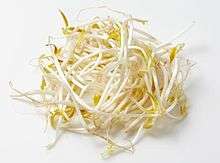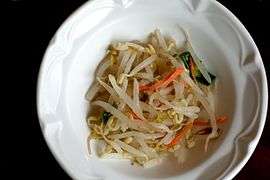Mung bean sprout
| Mung Bean Sprout | |||||||||
 | |||||||||
| Chinese name | |||||||||
|---|---|---|---|---|---|---|---|---|---|
| Traditional Chinese | 綠豆芽 | ||||||||
| Simplified Chinese | 绿豆芽 | ||||||||
| Literal meaning | green bean sprout | ||||||||
| |||||||||
| Vietnamese name | |||||||||
| Vietnamese | giá đỗ xanh | ||||||||
| Korean name | |||||||||
| Hangul | 숙주나물 | ||||||||
| Literal meaning | Sukju namul | ||||||||
| |||||||||
| Japanese name | |||||||||
| Kanji | 萌やし | ||||||||
| Kana | もやし | ||||||||
| |||||||||
| Malay name | |||||||||
| Malay | tauge halus | ||||||||
| Indonesian name | |||||||||
| Indonesian | taoge | ||||||||
Mung bean sprout is a culinary vegetable grown by sprouting small and round mung beans. It can be grown by placing and watering the sprouted mung beans in the shade until the roots grow long. Mung bean sprouts are extensively cultivated and consumed in East Asia.
Etymology
The Korean name "sukjunamul" is a compound of Sukju and namul, of which the former derived from the name of Sin Sukju(신숙주; 申叔舟), one of the prominent scholars who participated in creating hangul. Unlike his colleagues (later called the six martyred ministers) who had all pledged allegiance to King Danjong, Sin Sukju betrayed them in favour of Danjeong's uncle, Grand Prince Suyang (later King Sejo), who usurped the throne from his nephew and had him killed. People regarded Sin Sukju's move unethical and immoral, they started to give his name to mung bean sprouts, which happened to go bad and spoil very easily.[1]
Culinary use
Korea

_2.jpg)
In Korea, the word sukjunamul(sometimes abbreviated as sukju) refers to both the mung bean sprouts themselves and the namul(vegetable side dishes) made from mung bean sprouts. Sukjunamul is not as common an ingredient as kongnamul(soybean sprout) in Korean cuisine, but it is used in bibimbap and fillings of mandu(dumplings) and sundae(Korean sausage).
Ingredients
- manduso – mandu(dumpling) filling, made of minced meat, crumbled tofu, kimchi, mung bean sprouts, garlic chives, etc.
Dishes
- baechujjim – a type of jjim, made by stuffing parboiled napa cabbage with seasoned fillings made of ground beef, ground pork, and mung bean sprouts, then steaming it
- Jinju bibimbap – a type of bibimbap from Jinju, whose main ingredients are headless mung bean sprouts, soft inner leaves of spinach, young brakenfern, and finely shredded balloon flower roots. It is usually served with seonjiguk(blood soup).
- ojingeo sundae – stuffed squid, but considered a type of sundae. It can be made by stuffing a squid with ground beef, chopped green chilli, crumbled tofu, and mung bean sprouts, then steaming it
- simnamul – a type of namul, made by soaking dried beef tendons, slicing them thinly and blanching them, then mixing them with mung bean sprouts and seasoning them
- sukjunamul – a type of namul, made by blanching mung bean sprouts, then seasoning them with soup soy sauce, sesame oil, and toasted sesame seeds. It is a common dish for jesa(ancestral rite).
- sundae – also called korean sausage, made by steaming pig's intestines stuffed with seasoned ground meat, crumbled tofu, mung bean sprouts, chopped scallions, seonji(blood), cellophane noodles, etc.
See also
References
- ↑ 송, 백헌 (9 June 2016). "숙주나물, 성삼문과 멀어진 신숙주의 변절" [Sukjunamul, the betrayal of Sin Sukju who became estranged from Seong Sammun]. Joongdoilbo (in Korean). Retrieved 3 January 2017.